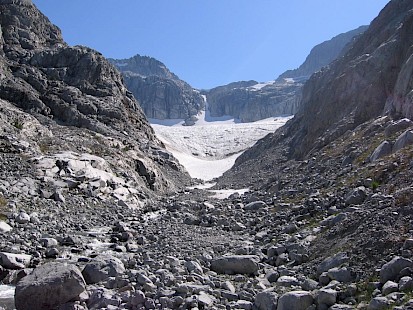Metro Vancouver's last remaining glacier is disappearing fast
 Metro Vancouver’s last surviving glacier, a source of local fresh water, will disappear in less than 30 years, according to local scientists.
Metro Vancouver’s last surviving glacier, a source of local fresh water, will disappear in less than 30 years, according to local scientists.
Scientists say climate change is accelerating the demise of the Coquitlam Glacier. The ice pack, located 40 kilometres north of Vancouver, sits on a mountain more than 1,400 metres high.
During the warmer months, runoff from what’s left of the glacier provides about two percent of the water in the Coquitlam Reservoir. Although not a significant source of water, for scientists surveying its decline, the glacier’s disappearing act is a symptom of the stress climate change is putting on local sources of fresh water.
“It’s one of our best climate indicators of change, and I don’t expect it to last past 2050,” said Dave Dunkley, a geoscientist with Metro Vancouver.
The Coquitlam Glacier is the last of the glaciers that formed in the Metro Vancouver area during the Little Ice Age, a period of regional cooling in Europe and North America that began in the 1300s and lasted until about 1850.
According to Dunkley, it has been the only glacier in the region for about 100 years. He estimates there were once about six to 10 smaller glaciers in the region during the ice age.
Dunkley says the position of the Coquitlam Glacier protected it from disappearing like the other glaciers that formed during that period. It has two pockets — a sheet of ice sloped over the mountaintop and the lower glacier nestled in a bowl of rock. Over the years, the rock formations shading the ice bowl have provided relative protection against fierce sunlight.
Peter Marshall, a field hydrologist with Metro Vancouver, is measuring the glacier’s retreat. He says even though its contribution to the reservoir is not substantial, it is a harbinger of the water-planning challenges the region may face in the future.
“This is our last remaining glacier in Metro Vancouver’s water supply areas, and it’s disappearing quickly. Once it’s gone, we rely strictly on precipitation and runoff from snowmelt,” said Marshall.
Metro Vancouver announced this month that water levels in the region’s reservoirs are lower than usual as summer conditions extend well into October. The region says the low water levels are the result of a lack of precipitation since Aug.1, combined with a 20 per cent increase in water use during a warmer fall season.
Marshall says the glacier’s decline also affects water levels in creeks and rivers, impacting fish and wildlife.
“Water running off from the glacier is the water we’re seeing in a lot of our dry creeks and rivers. Without these glaciers, some creeks might run dry in periods of weather like this.”
‘An endangered species’
Dunkley has been photo-documenting the ice pack for more than 15 years and says it’s shrunk considerably right before his eyes.
“When I first came here in 2006, this was covered in ice,” he said, referring to the dry, rocky terrain overlooking the glacier’s upper pocket. He says the thinning ice is becoming more exposed to the sun and predicts that now “it’s going to decay fairly rapidly.”
Peter Marshall, with Metro Vancouver’s Environment and Watersheds Group, found the ice had receded by two to five metres in a matter of two weeks since his last trip to the glacier.
“A lot of that is seasonal snowmelt at the top of the glacier, but it’s certainly struggling in these warm and dry conditions.”
As for the lower glacier, not only has it retreated, Dunkley says the ice mass has lost elevation since he first started surveying it in 2006.
“The glacier is flattening. We’ve lost up to 10 metres in thickness since I first came here.”
He says the lower glacier used to have a bulge, but he likened its current shape to a pancake.
Since the end of the Little Ice Age, Dunkley estimates the lower glacier has retreated by roughly 720 metres.
Official estimates provided by Metro Vancouver show the lower glacier’s elevation between 2018 and 2022 has decreased between about four to 20 metres, while the upper glacier has receded by eight to 10 metres.
“It’s an endangered species, and it’s an iconic image of what’s happening in the region,” he said.
A depleting water source
Warmer October weather has resulted in a heavier flow of downstream runoff from the glacier, but Marshall says it’s not enough to adequately supplement the reservoir’s lower water supply.
As the stream flows out of the glacier to make its way to the Coquitlam River, he says much of the water will soak into the ground before making it into the river, with some trickling into the reservoir.
Marshall says water levels in the reservoir depend heavily on precipitation.
“And we know, our precipitation patterns are changing with climate change.”
He says the region actually lucked out this year with a deeper snowpack, which resulted in delayed snowmelt into the reservoir.
“That was the saving grace of the summer. If we had poor snowpack or no snow, it would be very challenging times right now.”
Given drought conditions in areas across the province, the B.C. government says it is developing a watershed security strategy for safe fresh water.
“We’re helping to improve planning for scarce water resources and increasing our understanding of glacial melt by expanding monitoring networks for stream flow, groundwater and snow,” it said in a statement, referring to the Climate Preparedness and Adaptation Strategy (CPAS).
For Marshall, the glacier’s vanishing act is a wake-up call.
“I think it’s important to look at this and realize how quickly these resources are disappearing,” said Marshall. “We can think about how we can conserve our drinking water as we move into the future.”
You can return to the main Market News page, or press the Back button on your browser.

